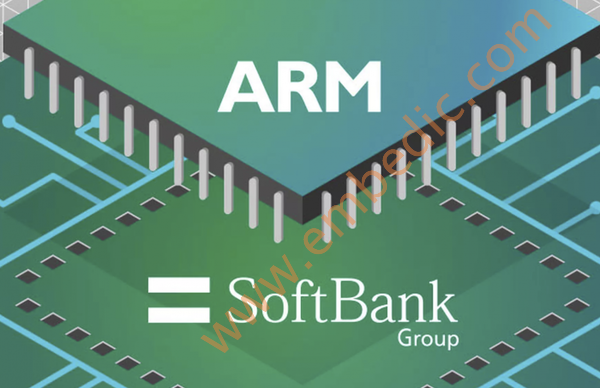
Arm announced its latest Cortex-M series, the new Cortex M55. In addition to some new improvements brought about by the new CPU microarchitecture, we have also seen the introduction of the new Ethos-U55 IP, which is designed to integrate with the new M55 core. Arm’s new IP aims to improve the machine learning and reasoning capabilities of billions of low-power embedded devices in the next few years, and expand its product portfolio to accommodate new use cases.
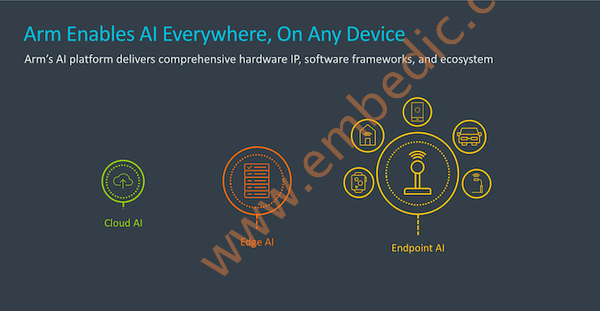
Edge AI is one of the biggest trends in chip technology. In other words, there are many AI functions that can be run locally without a cloud server connection. The most direct thing is to improve the running speed and privacy. Geoff Lees, senior vice president of edge processors at NXP, said, “Driven by new AI requirements and cloud-based processing challenges such as cost, latency, reliability and privacy,'Empowered Edge' has become a new megatrend. Arm’s new endpoint ML technology will help NXP’s many microcontroller-based developers to accelerate the edge processing of devices that are limited by size and power."
Here are a few examples:
One of the applications of IoT AI is something that already exists, but using Cortex-M55 and Ethos-U55 can take it to a new level. This device is not mandatory for everyone, but for those who need it, it may change lives. Here are some statistics: In the United States, 10 million people are registered as blind or partially blind. Globally, this number is close to 300 million. The device I want to talk about here is a connected cane. An early version already exists, and we found the following version: WeWalk, these devices use sensing and navigation functions to intelligently guide people to avoid indoor and outdoor dangers. The new AI includes new human assistance, voice and gesture-guided machine interaction, and predictive failure sensor systems, which will greatly change lives.
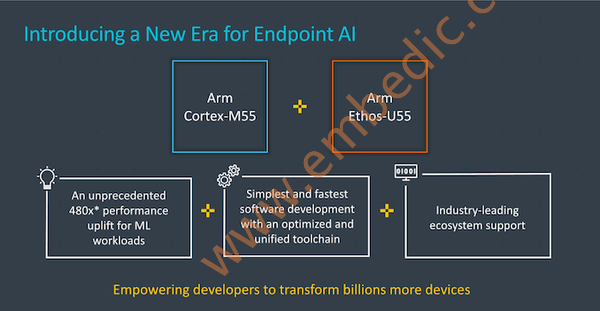
Talked to the Arm healthcare innovation team that our new Cortex and Eth operating system processors may undergo major upgrades. They told me that the biggest challenge facing connection developers today is their reliance on ultrasound positioning. But the range and fidelity of ultrasonic waves are limited, and the required sensing, processing, and power components tend to swell the design.
The new processor allows developers to use a 360-degree camera to replace ultrasound with AI-enabled visual sensing. In addition to wireless communication and navigation, it will also be powered by an ultra-thin battery that can last all day. The device looks like a traditional device, but it is the ultimate visual aid. Moreover, since AI calculations are performed locally, it does not matter if the unit connection is lost.
Next, let’s take a look at the new features of the newly released Cortex-M55 and Ethos-U55
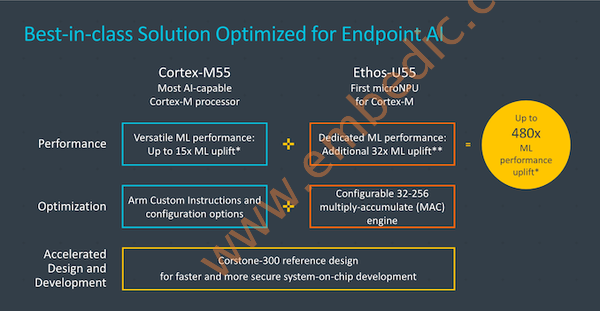
The new Cortex-M55 is a new generation of IP that is more closely related to M33, but it brings some new architecture improvements, and is expected to achieve greater performance and flexibility improvements in machine learning and vector instructions.
Ethos-U55 is a dedicated "microNPU" dedicated inference accelerator, which can be used in conjunction with Cortex-M CPUs, and provides the performance and energy efficiency of dedicated NPUs, or is usually brought to the desktop by the MAC engine-similar M-level IP takes up less space .
Cortex-M55: The first CPU core with Helium and custom instruction capabilities
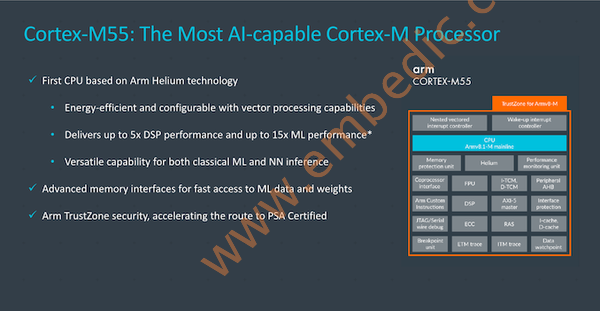
The new Cortex-M55 is very important because it is the first Arm CPU core that has both Helium (forgive me for not knowing how to call it in Chinese) and custom instructions. The technical name of Helium is actually MVE (for M-Profile Vector Extension), which is a new vector extension and dedicated vector execution unit in the M-class processor product series, making it the first CPU in the range with SIMD function. . The new function increases the DSP performance of the new core by 5 times. Compared with ML, the optimized instructions for ML workload are combined with MVE to increase the performance by 15 times.
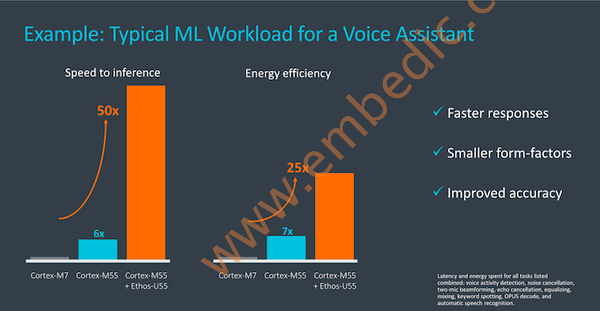
In terms of overall microarchitecture, it is the successor to the combination of M33 and µarch, and the increase in frequency will increase the performance of scalar workloads by approximately 20%, depending on the vendor's configuration. The core design focus is on bandwidth, and new MVE and new ML workloads that require bandwidth are enabled, so the memory subsystem has been improved, such as having four 32-bit interfaces to TCM (Tightly Coupled Memory).
Ethos-U55: Arm’s first microNPU
Arm is relatively late in the NPU field, because most vendors have adopted their own first-party IP architectures in their products, and most vendors are now using such implementations. However, the embedded market is different, and therefore requires a product with a much smaller area and power consumption than those normally used in "larger" implementations (for example, in mobile SoCs covered by Arm's Ethos-N) Product, NPU IP. This is the first product in the company's new "microNPU" neural network accelerator coprocessor for microcontrollers. Arm claims that combined with the newly released Cortex-M55, Ethos-U55 can increase machine learning performance by 480 times on the company's existing Cortex-M series products.
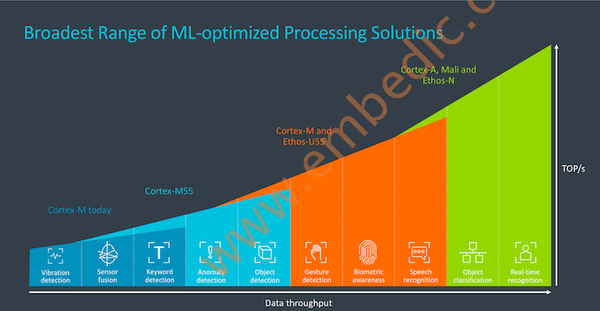
The new U55 is a small NPU that can be expanded from 32 MACs to 256 MACs and needs to be coupled with a Cortex-M NPU. Arm did not cover the main details of the microarchitecture, but it is a very streamlined design, focusing on area and power efficiency, and has a small memory footprint, including some of the features we see in the N series products , Such as weight reduction. What we are talking about is that U55 needs to be coupled with M-level CPU to be used as a controller, but in fact, this is not much different from the function of the N series, because the IP already contains M-level CPU, which is specially designed for low-power use cases. .
Compared with the previous generation solutions, the performance improvement of such systems using M55 and U55 represents a very important stepping function improvement. Compared with the Cortex-M7-based system, the data provided by Arm can increase performance by up to 50 times while increasing energy efficiency by 25 times.
As for where the new IP will be used, there are various embedded systems. Here we have to understand that the main part of this type of system will actually be a subsystem of the current existing chip. If you take a mobile device as an example, you will see that the subsystem uses IP in the fingerprint sensor of the phone, always monitors the audio chip in the voice assistant function, and even uses the subsystem in the RF system to optimize the workload, such as antenna tuning. There are hundreds of M-class processors in today's mobile devices that will benefit from ML functions, most of which are completely transparent to users.
Arm has currently licensed M55 and U55 to its main partners, and will open a wider range of licenses to other customers in the coming months. If suppliers have publicly confirmed whether they have used these designs in their products, it is expected that the final product will be on the market two years after the manufacturer’s secondary development.
Manufacturer: Texas Instruments
IC DIGITAL MEDIA SOC 529FCBGA
Product Categories: SOC
Lifecycle:
RoHS:
Manufacturer: Texas Instruments
IC DGTL MEDIA PROC 529FCBGA
Product Categories: DSP
Lifecycle:
RoHS:
Manufacturer: Texas Instruments
IC DGTL MEDIA PROC 529FCBGA
Product Categories: DSP
Lifecycle:
RoHS:
Manufacturer: Texas Instruments
IC DSP FIXED POINT 196NFBGA
Product Categories: DSP
Lifecycle:
RoHS:
Looking forward to your comment
Comment